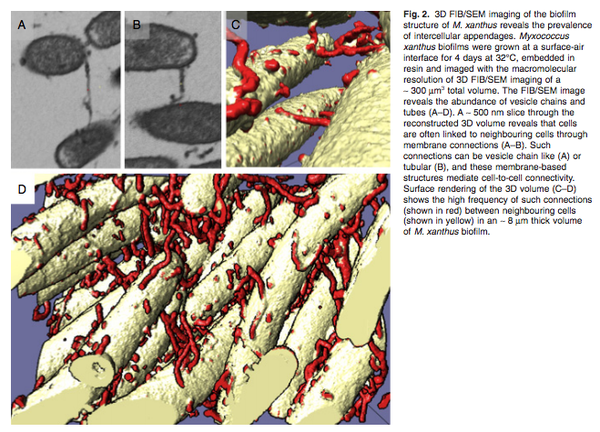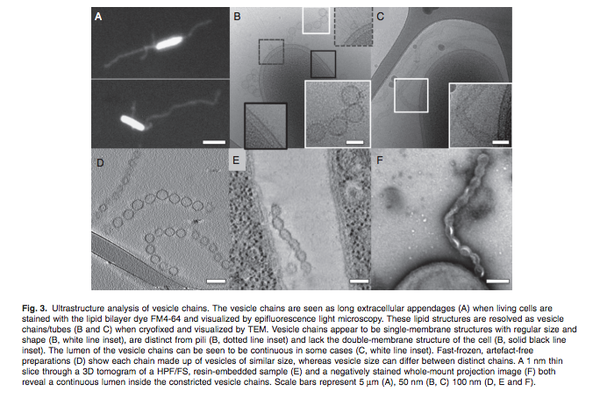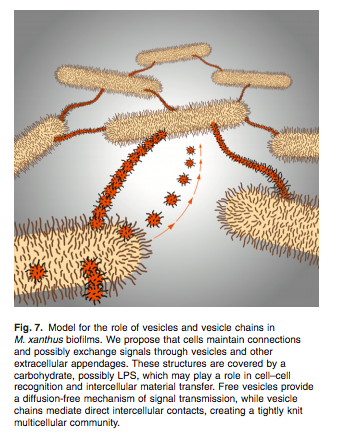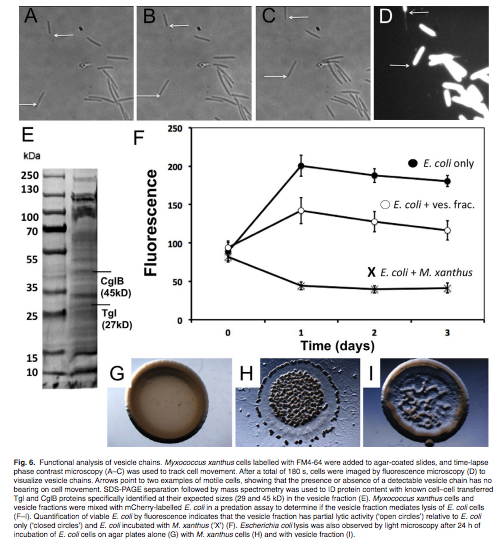The sociality of Myxococcus xanthus: Evidence of social group formation and interactive intelligence: Difference between revisions
| Line 32: | Line 32: | ||
<br> | <br>Balagam, Rajesh, Douglas B. Litwin, Fabian Czerwinski, Mingzhai Sun, Heidi B. Kaplan, Joshua W. Shaevitz, and Oleg A. Igoshin. (2014). Myxococcus xanthus gliding motors are elastically coupled to the substrate as predicted by the focal adhesion model of gliding motility | ||
Carmen Friedrich, Iryna Bulyha, Lotte Søgaard-Andersen. (2013). Outside-in assembly pathway of the type IV pilus system in myxococcus xanthus. Journal of Bacteriology,196(2), 378-390. | |||
Claessen, D., Rozen, D. E., Kuipers, O. P., Søgaard-Andersen, L., & van Wezel, G. P. (2014). Bacterial solutions to multicellularity: A tale of biofilms, filaments and fruiting bodies. Nature Reviews Microbiology, 12(2), 115-124. | |||
Dziewanowska K, Settles M, Hunter S, Linquist I, Schilkey F, et al. (2014). Phase variation in myxococcus xanthus yields cells specialized for iron sequestration. PLoS ONE, 9(4), 1-14. | |||
Eshel Ben Jacob, Israela Becker, Yoash Shapira, & Herbert Levine. (2004). Bacterial linguistic communication and social intelligence. Trends in Microbiology, 12(8), 366-372. | |||
Fiegna, F., & Velicer, G. J. (2003). Competitive fates of bacterial social parasites: Persistence and self-induced extinction of myxococcus xanthus cheaters. Proceedings of the Royal Society of London.Series B: Biological Sciences, 270(1523), 1534. | |||
Hagen, D. C., Bretscher, A. P., & Kaiser, D. (1978). Synergism between morphogenetic mutants of myxococcus xanthus. Developmental Biology, 64(2), 284-296. | |||
Hendrata, M., & Birnir, B. (2010). Dynamic-energy-budget-driven fruiting-body formation in myxobacteria. Physical Review. E, Statistical, Nonlinear, and Soft Matter Physics,81(6 Pt 1), 061902. | |||
Jonathan P. Remis, Dongguang Wei, Amita Gorur, Marcin Zemla, Jessica Haraga, Simon Allen, et al. (2013). Bacterial social networks: Structure and composition of myxococcus xanthus outer membrane vesicle chains. Environmental Microbiology, 16(2), 598-610. | |||
Konovalova, A., Petters, T., & Søgaardâ€Andersen, L. (2010). Extracellular biology of myxococcus xanthus. FEMS Microbiology Reviews, 34(2), 89-106. | |||
Nan, B., McBride, M. J., Chen, J., Zusman, D. R., & Oster, G. (2014). Bacteria that glide with helical tracks. Current Biology, 24(4), R173. | |||
Pathak, D. T., Wei, X., Bucuvalas, A., Haft, D. H., Gerloff, D. L., & Wall, D. (2012). Cell Contact–Dependent outer membrane exchange in myxobacteria: Genetic determinants and mechanism. PLoS Genetics, 8(4), e1002626. | |||
Pathak, D. T., Wei, X., & Wall, D. (2012). Myxobacterial tools for social interactions. Research in Microbiology, 163, 591. | |||
Pérez, J., Jiménez-Zurdo, J. I., Martínez-Abarca, F., Millán, V., Shimkets, L. J., & Muñoz-Dorado, J. (2014). Rhizobial galactoglucan determines the predatory pattern of myxococcus xanthus and protects sinorhizobium meliloti from predation. Environmental, | |||
Shimkets, L. J. (1999). Intercellular signaling during fruiting-body development of myxococcus xanthus. Annual Reviews in Microbiology, 53(1), 525-549. | |||
Smaldone GT1, Jin Y, Whitfield DL, Mu AY, Wong EC, Wuertz S, Singer M. (2014). Growth of myxococcus xanthus in continuous-flow-cell bioreactors as a method for studying development. Applied Environmental Microbiology, 80(8), 2461-7. | |||
Swapna Bhat, Tilman Ahrendt, Christina Dauth, Helge B. Bode, Lawrence J. Shimkets Department of Microbiology, University of Georgia, et al. (2014). Two lipid signals guide fruiting body development of myxococcus xanthus. American Society for Microbiology, 5 | |||
Velicer, G. J., Kroos, L., & Lenski, R. E. (2000). Developmental cheating in the social bacterium myxococcus xanthus. Nature, 404(6778), 598-601. | |||
Velicer, G. J. (2003). Social strife in the microbial world. Trends in Microbiology, 11(7), 330-7. | |||
Velicer, G. J., & Yuen-tsu, N. Y. (2003). Evolution of novel cooperative swarming in the bacterium myxococcus xanthus. Nature, 425(6953), 75-78. | |||
Vos, M., & Velicer, G. J. (2009). Social conflict in centimeter-and global-scale populations of the bacterium myxococcus xanthus. Current Biology, 19(20), 1763-1767. | |||
Wall, D. (2014). Molecular recognition in myxobacterial outer membrane exchange: Functional, social and evolutionary implications. Molecular Microbiology, 91(2), 209-220. | |||
Wartel M, Ducret A, Thutupalli S, Czerwinski F, Le Gall A-V, et al. (2013). A versatile class of cell surface directional motors gives rise to gliding motility and sporulation in myxococcus xanthus. PLoS Biol, 11(12), 1-12. | |||
Wei, X., Pathak, D. T., & Wall, D. (2011). Heterologous protein transfer within structured myxobacteria biofilms. Molecular Microbiology, 81(2), 315-26. | |||
Zhang, Y., Ducret, A., Shaevitz, J., & Mignot, T. (2012). From individual cell motility to collective behaviors: Insights from a prokaryote, myxococcus xanthus. FEMS Microbiology Reviews, 36(1), 149-164. | |||
Zusman, D. R., Scott, A. E., Yang, Z., & Kirby, J. R. (2007). Chemosensory pathways, motility and development in myxococcus xanthus. Nature Reviews Microbiology, 5(11), 862-872. | |||
<br> | |||
Revision as of 21:38, 21 April 2014
Introduction
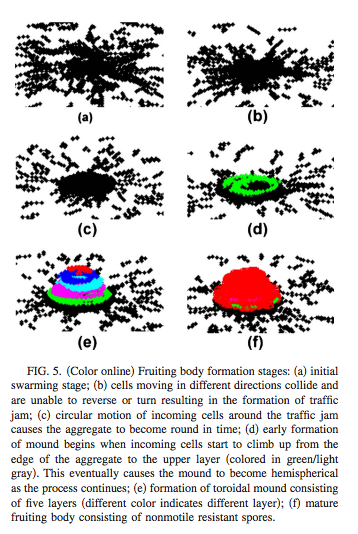
By Damaris Garduno
Other examples:
Bold
Italic
Subscript: H2O
Superscript: Fe3+
Balagam, Rajesh, Douglas B. Litwin, Fabian Czerwinski, Mingzhai Sun, Heidi B. Kaplan, Joshua W. Shaevitz, and Oleg A. Igoshin. (2014). Myxococcus xanthus gliding motors are elastically coupled to the substrate as predicted by the focal adhesion model of gliding motility
Carmen Friedrich, Iryna Bulyha, Lotte Søgaard-Andersen. (2013). Outside-in assembly pathway of the type IV pilus system in myxococcus xanthus. Journal of Bacteriology,196(2), 378-390.
Claessen, D., Rozen, D. E., Kuipers, O. P., Søgaard-Andersen, L., & van Wezel, G. P. (2014). Bacterial solutions to multicellularity: A tale of biofilms, filaments and fruiting bodies. Nature Reviews Microbiology, 12(2), 115-124.
Dziewanowska K, Settles M, Hunter S, Linquist I, Schilkey F, et al. (2014). Phase variation in myxococcus xanthus yields cells specialized for iron sequestration. PLoS ONE, 9(4), 1-14.
Eshel Ben Jacob, Israela Becker, Yoash Shapira, & Herbert Levine. (2004). Bacterial linguistic communication and social intelligence. Trends in Microbiology, 12(8), 366-372.
Fiegna, F., & Velicer, G. J. (2003). Competitive fates of bacterial social parasites: Persistence and self-induced extinction of myxococcus xanthus cheaters. Proceedings of the Royal Society of London.Series B: Biological Sciences, 270(1523), 1534.
Hagen, D. C., Bretscher, A. P., & Kaiser, D. (1978). Synergism between morphogenetic mutants of myxococcus xanthus. Developmental Biology, 64(2), 284-296.
Hendrata, M., & Birnir, B. (2010). Dynamic-energy-budget-driven fruiting-body formation in myxobacteria. Physical Review. E, Statistical, Nonlinear, and Soft Matter Physics,81(6 Pt 1), 061902.
Jonathan P. Remis, Dongguang Wei, Amita Gorur, Marcin Zemla, Jessica Haraga, Simon Allen, et al. (2013). Bacterial social networks: Structure and composition of myxococcus xanthus outer membrane vesicle chains. Environmental Microbiology, 16(2), 598-610.
Konovalova, A., Petters, T., & Søgaardâ€Andersen, L. (2010). Extracellular biology of myxococcus xanthus. FEMS Microbiology Reviews, 34(2), 89-106.
Nan, B., McBride, M. J., Chen, J., Zusman, D. R., & Oster, G. (2014). Bacteria that glide with helical tracks. Current Biology, 24(4), R173.
Pathak, D. T., Wei, X., Bucuvalas, A., Haft, D. H., Gerloff, D. L., & Wall, D. (2012). Cell Contact–Dependent outer membrane exchange in myxobacteria: Genetic determinants and mechanism. PLoS Genetics, 8(4), e1002626.
Pathak, D. T., Wei, X., & Wall, D. (2012). Myxobacterial tools for social interactions. Research in Microbiology, 163, 591.
Pérez, J., Jiménez-Zurdo, J. I., Martínez-Abarca, F., Millán, V., Shimkets, L. J., & Muñoz-Dorado, J. (2014). Rhizobial galactoglucan determines the predatory pattern of myxococcus xanthus and protects sinorhizobium meliloti from predation. Environmental,
Shimkets, L. J. (1999). Intercellular signaling during fruiting-body development of myxococcus xanthus. Annual Reviews in Microbiology, 53(1), 525-549.
Smaldone GT1, Jin Y, Whitfield DL, Mu AY, Wong EC, Wuertz S, Singer M. (2014). Growth of myxococcus xanthus in continuous-flow-cell bioreactors as a method for studying development. Applied Environmental Microbiology, 80(8), 2461-7.
Swapna Bhat, Tilman Ahrendt, Christina Dauth, Helge B. Bode, Lawrence J. Shimkets Department of Microbiology, University of Georgia, et al. (2014). Two lipid signals guide fruiting body development of myxococcus xanthus. American Society for Microbiology, 5
Velicer, G. J., Kroos, L., & Lenski, R. E. (2000). Developmental cheating in the social bacterium myxococcus xanthus. Nature, 404(6778), 598-601.
Velicer, G. J. (2003). Social strife in the microbial world. Trends in Microbiology, 11(7), 330-7.
Velicer, G. J., & Yuen-tsu, N. Y. (2003). Evolution of novel cooperative swarming in the bacterium myxococcus xanthus. Nature, 425(6953), 75-78.
Vos, M., & Velicer, G. J. (2009). Social conflict in centimeter-and global-scale populations of the bacterium myxococcus xanthus. Current Biology, 19(20), 1763-1767.
Wall, D. (2014). Molecular recognition in myxobacterial outer membrane exchange: Functional, social and evolutionary implications. Molecular Microbiology, 91(2), 209-220.
Wartel M, Ducret A, Thutupalli S, Czerwinski F, Le Gall A-V, et al. (2013). A versatile class of cell surface directional motors gives rise to gliding motility and sporulation in myxococcus xanthus. PLoS Biol, 11(12), 1-12.
Wei, X., Pathak, D. T., & Wall, D. (2011). Heterologous protein transfer within structured myxobacteria biofilms. Molecular Microbiology, 81(2), 315-26.
Zhang, Y., Ducret, A., Shaevitz, J., & Mignot, T. (2012). From individual cell motility to collective behaviors: Insights from a prokaryote, myxococcus xanthus. FEMS Microbiology Reviews, 36(1), 149-164.
Zusman, D. R., Scott, A. E., Yang, Z., & Kirby, J. R. (2007). Chemosensory pathways, motility and development in myxococcus xanthus. Nature Reviews Microbiology, 5(11), 862-872.

